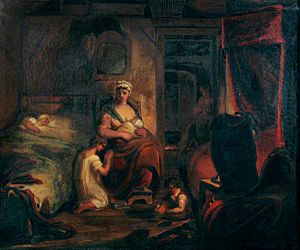William Martin (painter) facts for kids
William Martin was an English painter who lived from about 1753 to 1836. He was known for his "history paintings," which are artworks that show important events from history, stories from the Bible, or famous myths.
Early Life and Training
William Martin started his art journey as a student and helper to a famous artist named Giovanni Battista Cipriani. Martin even lived in Cipriani's house for over twenty years, learning from him.
In 1766, William Martin won a special award. The Society of Arts gave him a gold palette for one of his history paintings. This was a big achievement for a young artist.
Exhibitions and Royal Work
In 1775, Martin showed his art at the Royal Academy of Arts. He displayed a portrait and a painting called Antiochus and Stratonice. For the next nine years, he continued to show his work there.
His paintings often featured portraits of people. He also created scenes from the plays of William Shakespeare. Sometimes, he painted subjects from ancient Greek and Roman stories.
In 1791, he exhibited Lady Macduff surprised in her Castle of Fife. Later, in 1797 and 1798, he showed more portraits. Around 1800, Martin worked on special decorative paintings at Windsor Castle. This important job kept him busy for several years.
He continued to exhibit his art at the Royal Academy in 1807, 1810, 1812, and 1816. In 1810, he was even called 'Historical Painter to His Majesty'. This meant he was an official painter for the King.
Famous Engravings
Some of William Martin's paintings were turned into engravings. An engraving is a type of print made from a picture carved into a metal plate. This allowed more people to see his artwork.
Two of his paintings, The Death of Lady Jane Grey and The Death of Queen Eleanor, were in St. Andrew's Hall, Norwich. A famous engraver named Francesco Bartolozzi made prints of them. Bartolozzi also engraved Martin's painting called Imogen's Chamber.
Another important painting by Martin was The Barons swearing the Charter of Liberties at Bury St. Edmunds. This artwork showed a key moment in English history. It was engraved by William Ward using a method called mezzotint.
Other works like A Cottage Interior and The Confidants were also made into popular engravings. These prints helped spread William Martin's art to a wider audience.



